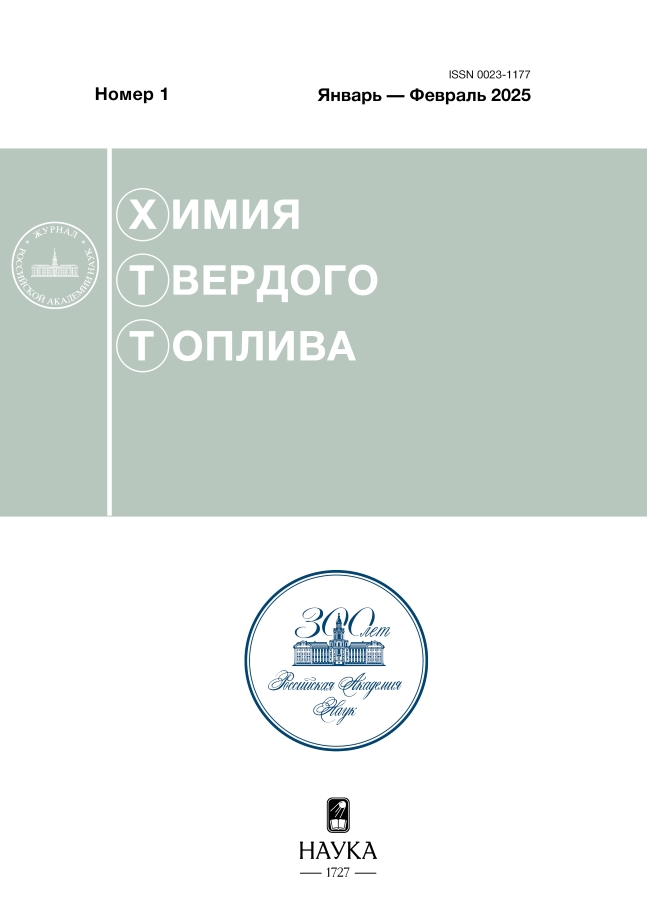Structural modification of humic acids in a barrier discharge plasma
- Authors: Yudina N.V.1, Ryabov A.Y.1, Kudryashov S.V.1, Zherebtsov S.I.2, Votolin K.S.2, Shpakodrayev K.M.2, Malyshenko N.V.2
-
Affiliations:
- Institute of Petroleum Chemistry of the Siberian Branch of the Russian Academy of Sciences
- Federal Research Center of Coal and Coal-Chemistry of Siberian Branch of the Russian Academy of Sciences, Institute of Coal SB RAS
- Issue: No 1 (2025)
- Pages: 106-112
- Section: Articles
- URL: https://archivog.com/0023-1177/article/view/684070
- DOI: https://doi.org/10.31857/S0023117725010141
- EDN: https://elibrary.ru/KSQGEX
- ID: 684070
Cite item
Abstract
The paper presents the results of the initiation of chemical transformations of humic acids (HA) in a barrier discharge plasma. The HA were treated with ammonia vapor in the presence of various gaseous media like ethylene, air, oxygen, carbon dioxide, and mixtures of argon. The method of EPR spectroscopy has revealed a decrease in the number of paramagnetic centers after treatment of HA in a barrier discharge. This suggests the recombination of free radicals in their structure. As revealed by IR spectroscopy, the intensity of the band at 1383 cm–1 corresponding to the NO3 group increased when HA were exposed to discharge plasma in air. When HA were treated with ammonia vapor in an argon atmosphere, ammonium humate was formed, which is completely soluble in water.
Keywords
Full Text
About the authors
N. V. Yudina
Institute of Petroleum Chemistry of the Siberian Branch of the Russian Academy of Sciences
Author for correspondence.
Email: natal@ipc.tsc.ru
Russian Federation, Tomsk
A. Yu. Ryabov
Institute of Petroleum Chemistry of the Siberian Branch of the Russian Academy of Sciences
Email: a.y.ryabov@yandex.ru
Russian Federation, Tomsk
S. V. Kudryashov
Institute of Petroleum Chemistry of the Siberian Branch of the Russian Academy of Sciences
Email: ks@ipc.tsc.ru
Russian Federation, Tomsk
S. I. Zherebtsov
Federal Research Center of Coal and Coal-Chemistry of Siberian Branch of the Russian Academy of Sciences, Institute of Coal SB RAS
Email: sizh@yandex.ru
Russian Federation, Kemerovo
K. S. Votolin
Federal Research Center of Coal and Coal-Chemistry of Siberian Branch of the Russian Academy of Sciences, Institute of Coal SB RAS
Email: kostvot@mail.ru
Russian Federation, Kemerovo
K. M. Shpakodrayev
Federal Research Center of Coal and Coal-Chemistry of Siberian Branch of the Russian Academy of Sciences, Institute of Coal SB RAS
Email: shpakodraevkm@mail.ru
Russian Federation, Kemerovo
N. V. Malyshenko
Federal Research Center of Coal and Coal-Chemistry of Siberian Branch of the Russian Academy of Sciences, Institute of Coal SB RAS
Email: profkemsc@yandex.ru
Russian Federation, Kemerovo
References
- Hur J., Lee B.-M., Shin K.-H. // Chemosphere. 2014. V. 111. P. 450–457. https://doi.org/10.1016/j.chemosphere.2014.04.018.
- Zhao J., Wang Z., Ghosh S., Xing B. // Environmental Pollution. 2014. V. 184. P. 145–153. https://doi.org/10.1016/j.envpol.2013.08.028.
- Юдина Н.В., Савельева А.В., Линкевич Е.В. // ХТТ. 2022. № 4. С. 20–25. https://doi.org/10.3103/s0361521922040097.
- Dobbs L.B., Canellas L.P., Olivares F.L. at al. // Journal of Agricultural and Food Chemistry. 2010. V. 58. № 6. P. 3681–3688. https://doi.org/10.1021/f904385.
- Zherebtsov S.I., Ismagilov Z.R. // Solid Fuel Chemistry. 2012. V. 46. № 6. Р. 339–351.
- Malyshenko N.V., Zherebtsov S.I., Smotrina O.V., Bryukhovetskaya L.V., Ismagilov Z.R. // Chemistry for Sustainable Development. 2015. V. 23. № 4. P. 451–457. [Химия в интересах устойчивого развития. 2015. Т. 23. № 4. С. 461–457. https://doi.org/10.15372/KhUR20150415].
- Филиппова О.И., Куликова Н.А., Бычкова Я.С., Воликов А.Б., Перминова И.В. // Проблемы агрохимии и экологии. 2015. № 1. С. 42–47.
- Skripkina T.S., Bychkov A.L., Tikhova V.D., Smolyakov B.S., Lomovsky O.I. // Environmental Technology & Innovation. 2018. V. 11. Р. 74–82.
- Юдина Н.В., Савельева А.В., Линкевич Е.В. // ХТТ. 2019. № 1. С. 34–40. https://doi.org/10.1134/S0023117719010092. [Solid Fuel Chemistry. 2019. V. 53. № 1. Р. 29–35].
- Sanito R.C., You S.-J., Wang Y.-F. // J. Hazardous Materials. 2022. V. 424. Р. 127390. https://doi.org/10.1016/j.jhazmat.2021.127390.
- Mumtaz S., Khan R., Rana J.N., Javed R., Iqbal M., Choi E.H., Han I. // Catalysts. 2023. V. 13. №. 4. Р. 685. https://doi.org/10.3390/catal13040685.
- Zabidi N.Z.A. // J. Phys.: Conf. Ser. 2021. V. 2071. P. 012004. https://doi.org/10.1088/1742-6596/2071/1/012004.
- Li S., Dang X., Yu X., Abbas G., Zhang Q., Li C. // Chemical Engineering Journal. 2020. V. 388. Р. 124275. https://doi.org/10.1016/j.cej.2020.124275.
- Zhou R., Zhou R., Wang P. Xian Y., Mai-Prochnow A., Lu X.P., Bazaka K. // J. Phys. D: Appl. Phys. 2020. V. 53. Р.303001. https://doi.org/10.1088/1361-6463/ab81cf.
- Zeghioud H., Nguyen-Tri P., Khezami L., Amrane A., Assadi A. A. // J. Water Process Eng. 2020. V. 38. Р. 101664. https://doi.org/10.1016/j.jwpe.2020.101664.
- Feng J., Sun X., Li Z., Hao X., Fan M., Ning P., Li K.// Adv. Sci. 2022. V. 9. Р. 2203221. https://doi.org/10.1002/advs.202203221.
- Jezierski A., Czechowski F., Jerzykiewicz M., Chen Y., Drozd J. // Spectrochimicaacta. Part A 56. 2000. P. 379–385.
- Ishiwatari R. // Geochemical J. 1974. V. 8. P. 97–102.
- Наканиси К. Инфракрасные спектры и строение органических соединений. Пер. с англ. М.: Мир, 1965. 216 с.
- Никамото К. Инфракрасные спектры и спектры КР неорганических и координационных соединений. М.: Мир, 1991. 535 с.
Supplementary files












